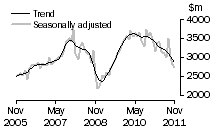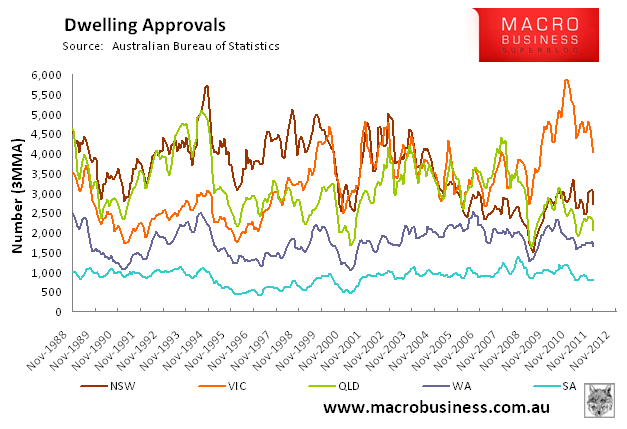By Leith van Onselen
The Australian Bureau of Statistics (ABS) has just released dwelling approvals data for the month of November and it has been bandied about as both good news and weak news within the blogosphere and by the market.
The headline number that is making news is a 8.4% increase in the number of dwellings approved in November 2011. This is in seasonally adjusted terms, following a fall of 10.0% in October. The result was well above the Bloomberg consensus of +6.0%
The state by state breakdown is as follows:
- Victoria: up 39.9%
- Queensland: up 6.6%
- New South Wales: up 2.0%
- Western Australia: down 16.9%
- Tasmania: down 7.9%
- South Australia: down 1.9%
Looking at private sector houses only, the breakdown is as follows:
- National: up 4.8%
- Victoria: up 13.0%
- Queensland: up 10.8%
- South Australia: up 2.3%
- New South Wales: up 0.3%
- Western Australia: down 4.9%
Digging deeper into the numbers, the value of total building approved decreased 2.6% in November in seasonally adjusted terms, following a decrease of 2.0% in October. The value of residential building fell 2.7% while non-residential building fell 2.5%. This is clearly not in an uptrend:

Turning to the key chart, which shows dwelling approvals on a 3-month moving average basis, Victoria’s dwelling approvals remain elevated, but have fallen below their peak level reached in mid-2010. On the other hand, Queensland’s, New South Wales’, and Western Australia’s dwelling approvals remain at relatively sluggish levels.

The ABS’ trend estimate for Australian dwelling approvals actually fell 2.2% in November, with private sector houses falling 0.8% and units an apartments falling 3.9%. The trend estimate is now 26% below the December 2009 peak, with all states experiencing monthly falls in trend terms.
Even with this “good news” in the background, expect calls for further rate cuts, boosts to building grants and other stimulatory measures to hasten from within the building and finance industry.

